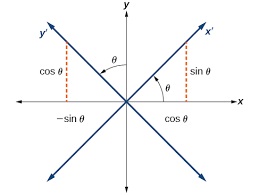Under a rotation of axes, a parabola can become a hyperbola.please give a short proof or a counterexample?
1 Answer
No, in no case a parabola changes to hyperbola on rotation.
Explanation:
A standard form of conic section does not have an
an ellipse is
or parabola
or hyperbola
Inn all these forms relative axes (axis pf symmetry in case of parabola) or directrix are parallel to one of axes i.e.
What a rotation of axes does is to rotate

and coordinates are modified and new coordinates
Let us observe the graph of an ellipse under rotation. First graph is
graph{(x-3/(2sqrt2))^2/(5/8)+(y+1/sqrt2)^2/(5/12)=1 [-1.4, 3.4, -1.8, 0.6]}
after rotation by
graph{5x^2-2xy+5y^2-9x-3y+5=0 [0.1, 1.7, 0.2, 1]}
but it remains as an ellipse.
Similarly a parabola graph{2sqrt2x^2-y=0 [-6.413, 6.387, -1.01, 5.39]} after rotation by
However, in no case a parabola changes to hyperbola on rotation.
